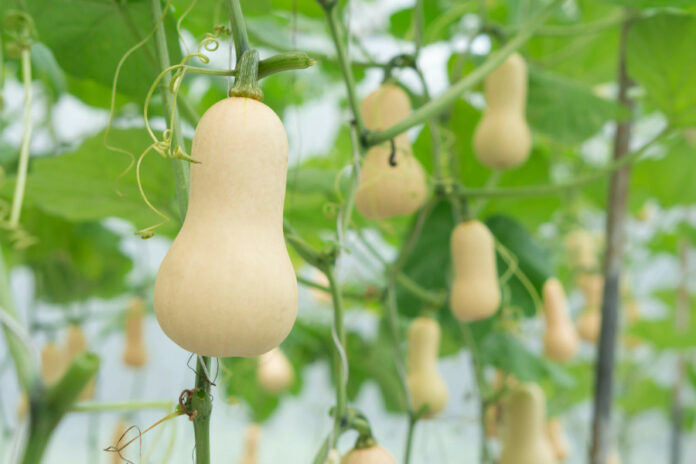You don’t have to be an expert in farming to grow butternuts.
This plant is easy to cultivate right from seed propagation to harvesting.
Indeed, butternuts grow, flower and produce fruit with little need for attention, and it is commonly said that the plants ‘grow themselves’.
What are butternuts?
Also known as butternut squash, butternuts are vine plants of the cucurbit or gourd family characterized by a long fleshy shank and a bulbous base.
They have a colorful, sweet and buttery flesh that is highly nutritious and low in calories.
Butternuts boast high levels of minerals, vitamins and antioxidants such as magnesium, potassium, and vitamins A, C, B1, B3, B6 and B9.
There are several species of butternut pumpkins distinguishable by shape, size and color of the fruit. Some of the most common ones include:
- Waltham – pear-shaped fruit that weighs up to 2kg.
- Honeynut – miniature butternuts that weighs about 500g.
- Atlas F1 – high yield hybrid variety with large fruits weighing 2-3kg.
Butternuts take an average of 90-100 days to mature after transplanting. A single vine can produce between 5 -20 fruits and 10-20 tons per hectare depending on the species and farm conditions.
Being a monoecious plant, butternuts depend on a heavy presence of bees for proper cross-pollination.
To achieve maximum yields, one beehive per acre is recommended.
Is butternut farming profitable?
Yes, butternut farming is a profitable venture. Being a super food, the fruits have a high demand and ready market.
This, coupled with the minimum input required in production, only spells one thing for the farmer; great profits.
That being said, there are a few requirements that you should take note of to help you navigate from the seed stage to great harvests.
Weather conditions
Butternuts thrive in warm to hot temperatures. They flourish under lots of sunshine, ideally 6-8 hours per day but overheating should be avoided.
Do your calculations well to avoid the cold season since frost is detrimental to butternuts. A single incidence can destroy a whole field of well-developed crop.
Soil
Like any other plant, good soil plays an important role in butternut farming. Well drained, nutrient rich soil with a pH range of 6.0-7.5 gives the best yield for butternuts.
It is advisable to carry out soil tests to determine the soil’s nutrient content. This will guide you on what to add to the soil for optimum production.
Planting
The land should be ploughed to loosen the soil. Adding organic manure at this stage to boost soil fertility would greatly benefit the plants.
RELATED: How Duncan Kibet makes a fortune growing butternuts
To plant butternut, make 2cm-deep holes that are one meter apart to give enough room for the runners.
Place 2-3 seeds into the shallow holes and cover lightly with a small amount of soil. Do not forget to water until they germinate.
Fertilizer
Butternuts are heavy feeders, which means they require lots of nutrients. Besides using rich soil, side dressing the plants using composted manure is advised.
In addition, liquid organic fertilizers which are vital in rooting, leaf growth, flowering and fruit development should be applied throughout the growth phases.
Watering
Although we have said the soil should be well drained, it should not be kept dry. In fact, you need to water the plants regularly to keep the soil consistently damp but not soaked up.
Too much watering can lead to the fruit absorbing water faster than it can produce skin – leading to bursting, literally.
It is important to note that dampness on the leaves of butternut fosters growth of mildew disease.
Consequently, you should direct water to the base of the plant.
If possible, use drip irrigation to water the plants.
Pests and diseases
Naturally, butternuts have a good resistance to most pests and diseases.
However, there are problematic ones that still attack the plants including powdery mildew, gummy stem blight, squash bugs, cut worms and fruit fly.
Luckily, all the above can be eliminated by readily available pesticides.
Spraying should be done in the evening to spare pollinators that are active during the day.
Harvesting
The most appropriate time to harvest your butternuts is when the fruits turn beige in color and the stem completely dries out.
Leave at least two inches of the stem attached to the butternut. This is to avoid creating a wound that would predispose the fruit to easy decay.
Let the fruits sit out in the sun for about two weeks. This practice is called curing and is vital in enhancing flavor and prolonging their shelf life.
Storage
To maximize their shelf life, wipe the butternuts with a mixture of water and bleach. This helps to kill bug eggs and mild spores that can attack them during storage.
Store the fruit in a cool, dry and well-ventilated place.
Turn and check the fruits regularly and thoroughly for any soft spots. Remove any fruit that has a soft spot immediately since rot spreads fast among them.
Conclusion
Little attention, minimal expenditure, short maturity period, solvable challenges and a ready market is a rare combination in agribusiness making butternut farming a lucrative venture.
If you have been toying with the idea of cultivating them, fear not; go forth, plant and make some cash in a few months.









am a greenhouse specialist,,, anyone willing to employee me am much available.contact: 0745382181